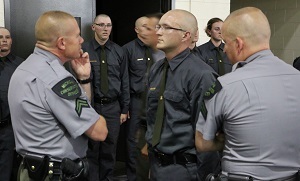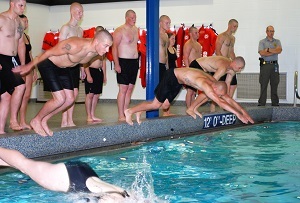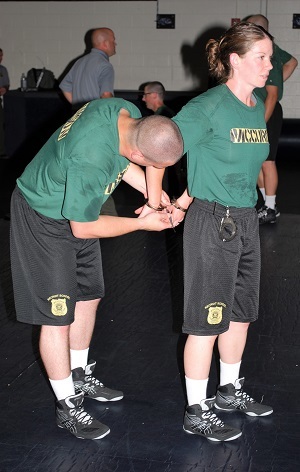Building better people
Week 1: July 16-22, 2017
The Michigan Department of Natural Resources will turn out two things when its Conservation Officer Recruit School concludes in December. One is the highest-quality conservation officer possible. The other is the highest-quality person possible. The priorities are not necessarily in that order.
The school’s emphasis on character is one aspect that separates it from traditional law enforcement training. Sure, its  academic, mental and physical requirements are finely honed to infuse the next generation of conservation officers with the skills they need to succeed. But the school’s overall objective is to build better people – and this year’s class is under construction. academic, mental and physical requirements are finely honed to infuse the next generation of conservation officers with the skills they need to succeed. But the school’s overall objective is to build better people – and this year’s class is under construction.
Character and citizenship are themes reinforced relentlessly during the 23-week academy. There is much to learn along the way, though. When recruits woke up to face their first full day of training, they saw just how far they have to go before earning the coveted green and gray uniforms.
Up and at ‘em!
It was still pitch-dark Monday when recruits’ alarm clocks screamed 5 a.m., but there was little time to shake the cobwebs from their heads. Recruits jumped into high gear and began their morning regimen of physical training, followed by breakfast and inspections of rooms and uniforms. It’s a routine that will drive recruits throughout the academy. After inspection, classroom work and hands-on training consume the rest of each day, from 8 a.m. to 5 p.m.
Recruits assembled in the classroom and first heard from DNR Law Enforcement Division Chief Gary Hagler. The chief’s challenge was clear. “You must be committed, dedicated and focused to graduate,” Hagler said. “The responsibility for your success lies with each of you.”
Assistant Chief Dean Molnar then shared his thoughts. “Make no mistake,” he said. “This is a rewarding career but it is also a lifestyle. This is who you are all day long. People in your work area will know who you are. If you truly want to put on this uniform and wear this badge, then you must earn it. You will not be disappointed in your choice of careers.”
 The class spent the rest of the morning with Lynn Ried of the Michigan Commission on Law Enforcement Standards (MCOLES). Ried’s thorough presentation covered the licensing requirements to become a Michigan law enforcement officer. The class spent the rest of the morning with Lynn Ried of the Michigan Commission on Law Enforcement Standards (MCOLES). Ried’s thorough presentation covered the licensing requirements to become a Michigan law enforcement officer.
Building law enforcement skills
Monday afternoon was a critical time as recruits began learning the basics of their chosen profession. All eyes were on Cpl. Steve Martin as he kicked off the survival tactics program, which provides the building blocks of necessary skills such as subject control, arrest procedures and ensuring officer safety.
Tuesday’s sessions began with instruction from Sgt. Jason Wicklund, school commander, who taught recruits the use and importance of computers as they relate to conservation law enforcement. In the afternoon, Cpl. Martin continued his survival tactics instruction. Recruits were issued handcuffs and repeatedly practiced the proper way to apply them. As fully commissioned peace officers, conservation officers must be able to restrain subjects to protect themselves and the public.
Attention to detail
Military procedure was Wednesday’s first topic as the class heard from Conservation Officers John Byars Jr., Richard Stowe and Casey Varriale.
"Attention to detail does not just pertain to your time at the academy,” said Stowe, a Recruit School instructor with military experience. “It is what will make you effective during your career in serving the people of Michigan. It also will help ensure you make it home every night.”
The afternoon was highlighted by an introduction to basic suspect control methods, which must be perfected before recruits can master more advanced techniques.
Health and fitness matter
The academy’s grueling nature demands recruits maintain healthy lifestyles. On Thursday, Cpl. Pat McManus instructed  recruits on health and wellness to enhance their resilience to the challenges they encounter. After the lecture, recruits faced an exhausting series of fitness and conditioning tests in the swimming pool. Conservation officers can expect to spend a lot of time in marine environments, whether enforcing boating and fishing regulations or performing lifesaving rescues. After lunch, the class received additional lessons in survival tactics. Recruits viewed several examples of dashboard camera footage that captured “use of force” incidents. Reviewing and discussing the footage allowed recruits to understand how quickly a contact can go from routine to life or death. recruits on health and wellness to enhance their resilience to the challenges they encounter. After the lecture, recruits faced an exhausting series of fitness and conditioning tests in the swimming pool. Conservation officers can expect to spend a lot of time in marine environments, whether enforcing boating and fishing regulations or performing lifesaving rescues. After lunch, the class received additional lessons in survival tactics. Recruits viewed several examples of dashboard camera footage that captured “use of force” incidents. Reviewing and discussing the footage allowed recruits to understand how quickly a contact can go from routine to life or death.
One week down, 22 to go
The academy is stressful for recruits, especially in the first week. To help them deal with it, Friday morning was devoted to interpersonal skills. Dr. Michael Comer, staff psychologist, worked with recruits to help them improve their interpersonal skills, which will help them now and well into the future since the stress of a law enforcement career can affect officers and their families.
After becoming familiar with the human resources and administrative support services available to conservation officers, the recruits were dismissed for the weekend. When they return Sunday night, it’s back to business. After all, Week 2 lies ahead.
Subscribe to the weekly conservation officer academy blog, which also will be posted on the Michigan DNR Facebook page. View previous blogs from Recruit School #8.
/Note to editors: Accompanying photos are available below for download. Caption information follows.
Passing + Inspection: A recruit is examined head to toe as instructors teach the proper way to wear the recruit uniform of a conservation officer. Recruits soon learn there’s only one right way to wear the uniform – the DNR way.
Conditioning + Test: Conservation officers must be comfortable on and in the water, as they frequently perform marine patrols and lifesaving actions. These recruits begin a Week 1 fitness test that gives instructors a baseline of each recruit’s conditioning level.
Survival + Tactics: Conservation officers must master survival tactics to be successful in the field. Recruits learn basics such as subject control, arrest procedures and ensuring officer safety. Pictured, recruits practice the proper way to apply handcuffs.
Keeping + Up + Strength: Proper nourishment is vital as recruits endure the academy’s rigors. From 5 a.m. to 10 p.m. recruits are on the move, and balanced meals provide the fuel they need to excel academically and physically.
Ready + To + Get + Wet: Recruits prepare to perform various conditioning drills in the swimming pool. The exercises not only provide instructors with a baseline as to each recruit’s conditioning level, but emphasize to the class that a conservation officer must be able to perform in a marine environment./
The Michigan Department of Natural Resources is committed to the conservation, protection, management, use and enjoyment of the state’s natural and cultural resources for current and future generations. For more information, go to www.michigan.gov/dnr.
|

 academic, mental and physical requirements are finely honed to infuse the next generation of conservation officers with the skills they need to succeed. But the school’s overall objective is to build better people – and this year’s class is under construction.
academic, mental and physical requirements are finely honed to infuse the next generation of conservation officers with the skills they need to succeed. But the school’s overall objective is to build better people – and this year’s class is under construction. The class spent the rest of the morning with Lynn Ried of the Michigan Commission on Law Enforcement Standards (MCOLES). Ried’s thorough presentation covered the licensing requirements to become a Michigan law enforcement officer.
The class spent the rest of the morning with Lynn Ried of the Michigan Commission on Law Enforcement Standards (MCOLES). Ried’s thorough presentation covered the licensing requirements to become a Michigan law enforcement officer. recruits on health and wellness to enhance their resilience to the challenges they encounter. After the lecture, recruits faced an exhausting series of fitness and conditioning tests in the swimming pool. Conservation officers can expect to spend a lot of time in marine environments, whether enforcing boating and fishing regulations or performing lifesaving rescues. After lunch, the class received additional lessons in survival tactics. Recruits viewed several examples of dashboard camera footage that captured “use of force” incidents. Reviewing and discussing the footage allowed recruits to understand how quickly a contact can go from routine to life or death.
recruits on health and wellness to enhance their resilience to the challenges they encounter. After the lecture, recruits faced an exhausting series of fitness and conditioning tests in the swimming pool. Conservation officers can expect to spend a lot of time in marine environments, whether enforcing boating and fishing regulations or performing lifesaving rescues. After lunch, the class received additional lessons in survival tactics. Recruits viewed several examples of dashboard camera footage that captured “use of force” incidents. Reviewing and discussing the footage allowed recruits to understand how quickly a contact can go from routine to life or death.




